
Shadow Boxing with Fight Club
How the Movie Fight Club Illustrates the Problem of the Inferior Function
Carol Shumate, December 1, 2011

The inferior function, Angelo Spoto said, is “not just a trouble-maker extraordinaire, it is a moral exigency as well.” The 1998 film exemplifies this dual quality of our fourth function as both nemesis and vehicle for type development, portraying our struggle with the function as literally a battle. Spoto’s description of the inferior function summarizes the movie’s theme: “In its most diabolical aspects, it tampers with and sabotages our relationships, turning friend into foe, or intrapsychically speaking, Self into non-self.” Fight Club dramatizes this strangely autonomous character of the inferior function by anthropomorphizing it into a separate character, a projection of the protagonist, who, in suppressing some parts of his psyche, inadvertently recreates them as external obstacles to be overcome.
The movie does not shy away from demonstrating how our tendency to project our non-preferred functions can lead to homicide, suicide, or even the breakdown of civilization. The violence is exhausting and many viewers cannot stay with the movie to the end. But Fight Club’s accomplishment is to elicit in us the instinctive fear, resistance, and embarrassment we all experience around the domain of our inferior function, whichever function that may be for us. The reward for sticking with the movie until the end is a catharsis that feels as if we have integrated our own inferior function. (And here we must acknowledge that this article is a spoiler: If you want to experience this cathartic effect of the movie, see it first before reading further.) In this way, the film makes the struggle worthwhile, suggesting that we can change the trajectory of our lives (and our civilization) by recognizing and owning our functions.
Part of what makes the movie an instructive vehicle for exploring psychological type is the exaggeration of the qualities that Jung associates with certain functions: introverted intuition (Ni), extraverted sensation (Se), and introverted sensation (Si). Of course, this exaggeration implies pathological dysfunction, but it also makes the functions visible to us, and suggests that we can reach psychic wholeness from the depths of our dysfunction by grappling with our own inferior function, the site of our inferiority complex.
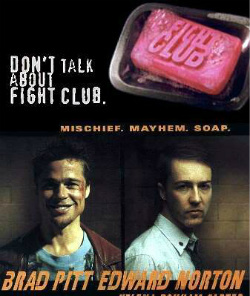
We see in Jack’s character the qualities Jung observes in the introverted intuitive type: “The intensification of intuition often results in an extraordinary aloofness of the individual from tangible reality” (CW 6, para. 661). The movie exaggerates this aloofness to the point of near-complete dissociation from reality. However, the main character’s internal monologue is so insightful and original that it illuminates the extraordinary richness of the interior life of Ni types, of whom Jung says, “They are living evidence that this rich and varied world with its overflowing and intoxicating life is not purely external but also exists within” (CW 6, para. 665).
Early visual cues that suggest Jack’s type as a youthful INTJ are his controlled movements, neat attire, and clean desk and apartment. Paul Tieger says that INTJs are characterized by “movements that are thoughtful and deliberate” (1998, 174) and in Ed Norton‘s portrayal, Jack moves almost robotically. He dresses conservatively, another INTJ attribute (Tieger, 1998), and his verbal interactions are clear, crisp, and dry, characteristic of an extraverted thinking (Te) auxiliary function. John Beebe has called Ni the “knowing” function, and Jack’s inflated Ni, together with auxiliary Te, makes him appear arrogant, smug, and callous. In contrast with his internal monologue which flows effortlessly, Jack’s actual conversation consists of pre-rehearsed remarks. [View video-clip]
We can see further evidence of extraverted thinking in Jack’s job, in which he applies a mathematical formula to fatal car crashes to determine whether it is more profitable for the automobile company to pay off the claimants or to recall the defective vehicle. Jung says of extraverted thinking that this type “elevates … an objectively oriented intellectual formula [my emphasis] into the ruling principle not only for himself for but his whole environment” (CW 6, para. 585). Jack adheres to the formula ruthlessly, to the extent that he frightens a fellow passenger on a plane trip when he tells her about his job. “In keeping with the objective formula,” says Jung of extraverted thinking, “the conscious attitude becomes more or less impersonal, often to such a degree that personal interests suffer” (CW 6, para. 589).iii
We can also see Jack’s type in his almost complete repression of sensation, as perhaps could be expected of a youthful Ni dominant individual, though with Jack this is pathologically exaggerated. He inhabits a world of extreme sensory deprivation. He lives in a bland apartment and works at a bland job—or rather, he manages to make his job bland. In fact, his job of analyzing fatal car crashes is graphically sensational, but his exclusive focus on the formula reduces these dramas to figures on paper, causing his job to resemble the actuarial work of insurance. His apartment is a perfectly organized, Ikea-furnished apartment–all white, beige, and undifferentiated, like Jack himself. [View video clip] Paper white is the color of his life and he is a paper man who takes up residence on Paper Street. He appears, like his apartment and his office, to be a man without shadow.
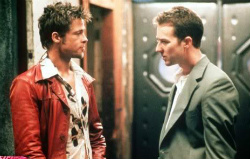
TYLER: Look at you. You’re pathetic. Why do you think I blew up your condo? Stop trying to control everything and just let go. Let go!
Here, the credo of extraverted sensation—‘be spontaneous’—is exaggerated by the barbarous quality of the inferior function, which always remains primitive in us. In the dominant position, extraverted sensation is fluent and persuasive; if undeveloped, however, as in the inferior position, it can be brutish and bullying.
Ever the primitive, Tyler urges Jack to give vent to his most violent impulses by creating the Fight Club, which, tellingly, is hidden underground. The club becomes the visual expression of inferior extraverted sensation, but also of the addictive rush that can be had from projecting our own animal instincts onto others and then attacking them for the same. It exemplifies the drive that feeds war, genocide, and mob rule. As Spoto observes: “Because the inferior function is so tied to the side of an individual’s personality, we must realize that the inferior function, when it is at the heart of such projections, can actually be dangerous.”
We can’t bear to accompany Jack into Tyler’s barbaric world, and we are tempted to quit watching. Why, we wonder, does Jack let this brute dominate him? Why doesn’t he fight back? Of course, he does fight back, and that is the point: Fighting back does not work. The inferior function cannot be simply overcome, or resisted. At the same time, to fight is mandatory. That is what makes Fight Club an iconic representation of the intra-psychic struggle with the inferior function.
Jung suggested that the inferior function can exercise a near-fatal attraction over us. Marie-Louise von Franz, Jung’s protégé, has described Hitler’s rise to power as a function of his ability to appeal to the inferior function of his audience (1971, 68). Like Hitler, Tyler appeals to his audience’s inferior function. Not surprisingly, the rules appeal to Jack’s attachment to intellectual formulas. The men who are drawn to the club all have suits and briefcases. They all resemble Jack—i.e., men who have repressed extraverted sensation and who can only experience it negatively, through violence. Von Franz says that the voice of the inferior function expresses itself in clichés and in primitive ways. Tyler’s innumerable mottos and rules have the quality of clichés, delivered with the hypnotic power of one who tells the audience what it wants to hear:
TYLER: The first rule of Fight Club is: You do not talk about Fight Club.
The second rule of Fight Club is: You do not. Talk. About Fight Club.
The rules are simplistic, primitive, and irrational as von Franz predicts. The repetition adds form without content, creating nonsense: If no one talked about the club, how would it gain members? The rules also show occasional flashes of brilliance, as is sometimes the case with the inferior function, but often this brilliance is dangerously cruel, as is the case with Rule #8: “If this is your first time … you have to fight.” Note the little sneer in Tyler’s face after he delivers this final rule. [View video-clip] The Fight Club rules reflect the dangerous desire of the ego to dominate and silence the other parts of the self and to prevent the conscious self from acknowledging its unconscious projections.
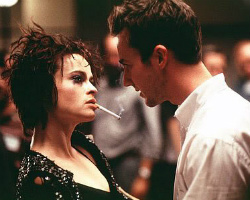
Jack’s divorce from his Sensing and Feeling functions is so extreme that at first he is unaware of being attracted to Marla, and is even unaware that she is attracted to him. It is Tyler who takes up the Marla challenge with gusto, when Jack himself (or at least his conscious self) neglects Marla. As Beebe has observed (2005), a neglected inferior function, when in the guise of the Anima, can manifest this neglect by appearing in our dreams as disheveled and impoverished. When Marla first appears, she seems the chic dramatic femme fatale. But around Jack she takes on the crazed look of a street person with punked-out hair and sloppy clothes. [View video-clip]
Jack’s neglect of extraverted sensation is also symbolized by the state of his house, or rather, Tyler’s house. Jack has traded his perfect but bland apartment for Tyler’s extraverted sensation mess, which becomes a visual representation of Jack’s escalating psychic disintegration. The house resembles the worst kind of college fraternity house that no one has any obligation to clean or maintain. As the movie progresses, holes begin to appear in the walls, the plaster and wallpaper begin to peel off in strips, and worst of all, the house develops plumbing problems. Drips become leaks, which become standing water in some rooms, and the water rises threateningly higher over the course of the film, symbolizing the encroachment of Jack’s unconscious impulses.
Jack is so unconscious that he only realizes his feelings for Marla when Tyler takes her to bed. Now, Jack is simultaneously tormented by Tyler’s bullying taunts and by his jealousy of Tyler’s sexual relations with Marla, and his bitterness and violent impulses escalate, even though it alarms him. Jack’s appeasing strategy of indulging Tyler’s excesses backfires, and Tyler’s violent demands only increase.
Von Franz describes this insatiability as characteristic of the Anima, which Jung associated with the inferior function (1980, 93):
…the rejected content turns up again in a new projection in the individual’s environment, as one sees in the case of Don Juan, who chases one woman after another in his search for the one inner image of woman (anima), only to realize, in the moment of possession, that it is not ‘there.’
Thus, an un-integrated inferior function will drive us, like Don Juan, to seek its image again and again, in ever-new guises.
In Jack, we see this multiplication effect in the escalating fights he engages in with a steady procession of new combatants. The numbers of fighters swell to the size of an army. They even take on the look of soldiers; gone are the suits and briefcases, replaced by camouflage uniforms and weapons. At this point, the Fight Club has entirely disappeared and an army occupies Jack and Tyler’s house.
This marks a sea change in the movie, a shift from extraverted sensation in its raw, untrammeled experience of the moment, into unconscious, and therefore out of control, introverted sensation. The soldiers obey orders unquestioningly, as is characteristic of undeveloped introverted sensation. Lenore Thomson says of Si types that they “use rules and regulations to bring outer reality into line” and “insist on the letter of the law” (1998, 175). As with any function that remains unconscious, this characteristic becomes dangerously exaggerated in Jack’s psychic house. Tyler dreams up ever more violent missions for the soldiers, and the army of men goes out to assault the world, terrorizing random citizens, vandalizing stores, overturning cars, blowing up civic transportation. When Jack, alarmed, asks the soldiers what they’ve done, the reply is: “Sir, the first rule of command is, you do not ask questions, sir.” This shows how grotesquely the Flight Club formula has mutated, and how determined the ego is to refuse Jack admittance to his unconscious.
At this point, what was masochism becomes sadism, and suicidal tendencies become homicidal. John Beebe’s model of eight functions and archetypes posits that, whereas we have four functions in consciousness, we also have access to the other four functions but we tend to be unaware of them; that is, they tend to remain sunk in our unconscious. Beebe’s model places Si in the eighth or Demonic / Daimonic position for INTJ. Jung said that our inferior function can act as a bridge to the unconscious, and, thanks to Beebe’s model, we can actually watch Jack travel along the bridge of his inferior Se into his unconscious Si function. As soon as Jack’s Se is awakened—after he has thoroughly explored it in the Fight Club and via other forms of self-mutilation—it confronts him with his unconscious Si function, which, personified by the soldiers, takes on a truly demonic dimension as Beebe’s model predicts. Lest we have any doubt about the role of the soldiers as unconscious manifestations, or of Tyler’s mediating role between the ego and the unconscious, Tyler makes it overt: “We guard you while you sleep,” he says while the soldiers pin down one of their victims; “Do not f___ with us.” The real target of the message is Jack himself.
The army of soldiers represents the tremendous power we give others over us when we project our less-preferred functions on them. The more Jack tries to exclude, repel, and control the soldiers, the more they encroach on his territory, multiplying and taking over his home. Whereas Si in the dominant (or Heroic) position remembers, maintains, and preserves, Jack’s Si soldiers plot destructive military actions and laugh as they watch buildings burn on TV. We know they are Jack’s because they address him as their commander. The house too takes on the distorted quality of the unconscious, as its inhabitants, the soldiers, exhibit ever-more extreme regimentation—introverted sensation grown pathological. Tyler’s Se fun house has mutated into something resembling a military barracks on the front line: Its windows are boarded up, and it contains no furniture, nothing but maps of military operations and logs of “human sacrifices.”
The disastrous impact of Jack’s psychic split on the world around him is predicted by Jung (CW 9ii, para. 126):
The psychological rule says that when an inner situation is not made conscious, it happens outside, as fate. That is to say, when the individual … does not become conscious of his inner opposite, the world must perforce act out the conflict and be torn into opposing halves.
Jack’s inability to make conscious his introverted sensation distorts the aspect of Si that records, tracks, and archives experience. His incapacity to access his Si manifests as amnesia. Ni dominant individuals have said that, to the extent that they can grow aware of their introverted sensing, it can manifest as an inability to remember positive moments (Beebe, 2010). Because introverted sensing is focused on recalling lived experience, to be unconscious of it is to lose out on a part of our history. Poor Jack cannot even remember making love to Marla.
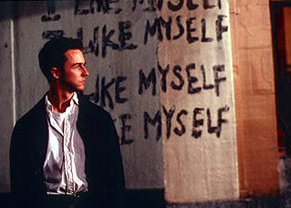
Spoto’s warning about the danger of the inferior function is realized in the film when Tyler tells Jack that Marla must be eliminated because: “She knows.” Although Tyler appears to want Jack to reclaim his repressed aggression, in reality Tyler is invested in keeping Jack ignorant and enslaved. The inferior function, however weak it may be in us, is still after all a conscious or ego-syntonic function—a part of our persona. Bridge to the unconscious though it is, the inferior function nevertheless can generate a fair amount of resistance to the revelation of our unconscious drives. Tyler illustrates this push-pull effect of the inferior function vis-à-vis the unconscious. Jack has no idea what Tyler means. He still doesn’t recognize himself in his myriad projections, believing that Tyler is a real person. But his recognition that Tyler is a serious threat to Marla enables him to push through his defenses and perform the difficult task of overthrowing his ego from its throne.
Together, Marla and Tyler demonstrate how projection can be either creative or destructive. Jack’s projection of Se on Tyler almost kills him; his projection on Marla saves him. How can projection possibly be a good thing? Jung tells us how: “If the soul-image is not projected, a thoroughly morbid relation to the unconscious gradually develops” [my emphasis] (CW 6, para 811). Marla draws Jack out of his intellectualizing, his fantasies, and his self-pity. She saves him from his already ‘morbid relation’ to his unconscious, leading him to reality, and to wholeness. What Marla has “ruined” is Jack’s neat compartmentalization of his psyche. By luring his projected Se from Tyler to herself, Marla saves Jack from dissociating. We know this has happened when Tyler goes missing; then Marla alone carries Jack’s extraverted sensation.
However, the Anima-projection phase must be short-lived, says Jung: “We cannot in the long run allow one part of our personality to be cared for symbiotically by another; for the moment when we might have need of the other function may come at any time and find us unprepared” (CW 7, para. 86). In fact, Jack has desperate need of his extraverted sensation to arrest the impending terrorist action of Tyler’s army.
Propelled by his fear for Marla’s safety, Jack begins to change. The smug wooden protagonist from the early part of the film is gone. His movements are fluid and quick, his interactions no longer bitter but pragmatic. He has dropped the formulas and the rehearsed witticisms. He relinquishes the illusion of control in order to take authentic control, and so he surrenders the dominance of the knowing part of himself, his dominant Ni. He knows that he does not know, but he must act without knowing.
In the final scene,iv Jack learns the truth of who Tyler is. When Tyler reappears, Jack tries to kill him but the bullets pass right through him to no effect. Now Jack understands how projections work. One cannot just kill them off, and it isn’t enough to know that they are part of oneself. One must confront them at the source: the ego.
Jack sees that the only way to regain control of his projections is to sacrifice part of himself, and he decides to shoot himself. Horrified by Jack’s intention, Tyler tries to talk Jack out of it, and begins to bargain with him, and then to threaten him, and here again we hear the voice of ego, desperate to contain us.
In the ultimate extraverted sensation act, Jack shoots himself through the chin and falls to the floor. Symbolically, this scene is emblematic of how, in order to gain access to our inferior function, we must release the grip of our superior function. Tyler’s body, a projection, disappears but Jack remains alive. This is how the ego is—it threatens us with death if we disobey, but if we refuse to listen, we do not die. The world does not end. By committing what James Hollis calls egocide (2007, 237), Jack defuses the demonic potential of his threatening multiple selves, his suppressed, rampaging functions, personified by Tyler Durden and the soldiers. Jack is wounded but empowered. With this act, Jack is also able to make conscious other unconscious functions including, notably, introverted sensation: He is able to recall (Si) the soldiers and re-collect (Si) the scattered parts of himself, which saves Marla’s life and his own.
The last scene of the movie shows the skyscrapers of the city exploding and falling in an eerily prophetic glimpse of 9/11, the most historic acting out of shadow impulses in our time—prophetic because the movie pre-dates 9/11 by three years. [View video-clip] The significance of this coincidence is uncomfortable, as befits the inferior function. It suggests that we are all terrorists, that we all have a Fight Club within us. We must all unseat our ego, comprised of our conscious functions, and especially our Hero or dominant function, in order not to be overrun by our Shadow functions. In order to resist the tyranny of others, we must learn how to deal with the tyrannical aspects of our own ego, which tends to treat our inferior and unconscious aspects as rogues and rebels. If we do not acknowledge these lesser aspects, the rogue aspects will tyrannize us themselves.
Notes
i I’m grateful to Hile Rutledge for this insight, shared on November 1, 2011.
ii Of course other type codes could be inferred in the characters. An argument could also be made for Jack as an INTP. Beebe observes that one cannot directly integrate the inferior function, and has suggested a novel route to reach the inferior: via one’s Trickster archetype. Beebe’s model correlates the Trickster archetype with the 7th function in any type code, opposite in attitude to the tertiary. For an INTP code, the 7th or Trickster function is, appropriately, Se. Tyler as Se would then represent Jack’s Trickster. Beebe has also noted a correlation between bipolar disorder and the Trickster archetype, and Marla exhibits some manic behavior, lending further support to the idea that she and Tyler could represent Se in the 7th position. Certainly, Tyler tricks Jack, and Jack’s final act is a tricksterish one, the only way possible out of the double bind that he’s in. However, Marla seems to play an Anima role toward Jack, which argues that she corresponds to Jack’s inferior function, indicating INTJ for Jack. It seems a stretch to see Marla as an extraverted feeling (Fe) type, the inferior function for INTP.
iii One could question whether Te or Ni is dominant, except that Jack is clearly a dominant introvert, revealing little of himself to others.
iv The ending of the movie differs from that of the book. This article refers to the movie ending.
References
Beebe, J. (2004). Understanding consciousness through the theory of psychological types. Analytical psychology. Ed. Joseph Cambray and Linda Carter. New York: Brunner-Routledge. 83-115.
Beebe, J. (Winter, 2005). Evolving the eight-function model. APT Bulletin, pp. 34-39 (revised
version of article originally published in TypeFace, July, 2005).
Beebe, J. (August 4-7, 2010). Workshop: The battle within: How interactions between our archetypes affect us. Chicago, IL.
Hollis, J. (2007). Why good people do bad things: Understanding our darker selves. New York, NY: Gotham Books.
Jung, C. G. The collected works of C. G. Jung, trans. R. F. C. Hull. Bollingen Series XX, vols. 1-20. Princeton, NJ: Princeton University Press.
Jung, C. G. (1923, 1971). Psychological types. CW 6. Trans. R. F. C. Hull. Bollingen Series XX. Princeton, NJ: Princeton University Press.
Jung, C. G. (1953, 1966). Two essays on analytical psychology. CW 7. Trans. R. F. C. Hull. Bollingen Series XX. Princeton, NJ: Princeton University Press.
Spoto, A. (1995). Jung’s typology in perspective. Rev. Ed. Wilmette, IL: Chiron Publications.
Thomson, L. (1998). Personality type: an owner’s manual. Boston, MA: Shambhala Publications.
Tieger, P. and B. Barron-Tieger. (1998). The art of speedreading people. New York, NY: Little, Brown, & Co.
von Franz, M-L. (1971). “The inferior function” in M-L von Franz and James Hillman lectures in Jung’s typology. Zurich: Spring.
von Franz, M-L. (1980). Projection and re-collection in Jungian psychology: reflections of the soul. Trans. William H. Kennedy. Open Court: 1980.
Uhls, J. (1998). Fight Club screenplay, based on the novel by Chuck Palahniuk (1996).


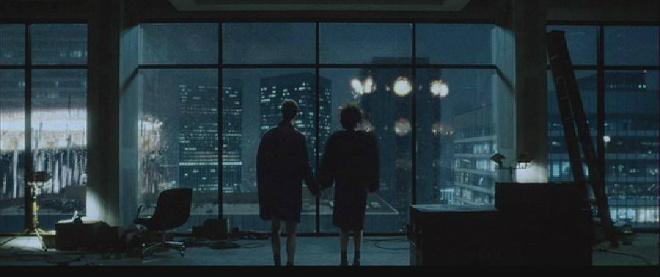





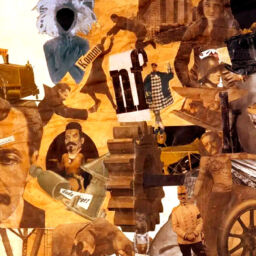
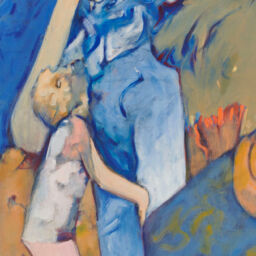









[…] the comedic relief. There's an article on this for Fight Club, but spoilers if you haven't seen it: Shadow Boxing with Fight Club – Personality Type in Depth Originally Posted by fresh Frozen Fever presents the most evidence against her being an INFP […]
[…] Shadow Boxing with Fight Club […]
Jung: “The language I speak must be equivocal, that is ambiguous, to do justice to the psychic nature [of things]. I strive consciously and deliberately for ambiguous expressions, because it is superior to unequivocalness and corresponds to the nature of being.” “My … style is by no means simple and it wants a specifically trained ear to hear the somewhat suble innuendos, which abound in [my writing]. … Certain points are misunderstood by [those] who do not grasp the full value.”
Jung… I feel you bro.
Plato: “As a young man I reflected a lot about how society could be improved … but I refrained from action.”
Hehe what ? I wont tell why you are wrong because it would make you angry and irrational but I will tell you how to prove yourself wrong depending on your analytical and abstract thinking. I wonder how it would feel like. Shame perhaps ? 1st learn about INFJ 2nd learn about INTJ 3rd Look for real people examples of INTJ and INFJ and maybe compare if its not much go ask. 4th google writer of the book and director of the movie with INFJ in bar. Start thinking at this point but not too much. 5th check IMDB bio of writer and director. Look for clues scooby. 6th watch the movie again. 7th come back with better response than “I don’t think…” Bonus points for researching which actor was considered first fo play Tyler and his personality type and Brad’s.
Good effort for trying to use my own argument to support what you “think” Like I would allow myself to make a mistake like that.
The article and INTJ theory makes sense because there are good arguments and they are convincing. Similar to Hitler.
‘@Jack, you frankly make no sense. I don’t think Jack is an INFJ but INTJ makes more sense. Your own argument that he is emotionally repressed arguably supports this point, since feelers are well, feelers, after all. I also don’t think Tyler is an ESTP but more likely an ESFP (that’s why his rules make no real sense), and I also think Marla is an ESFP. That’s why Jack is so drawn to her because she’s his anima, as suggested in the article.
Is David Fincher INFJ ? He did the thinking. Fight Club did the Talking. It too perfect to be true.
Do you remember the scene in restaurant ? When he asks about his name ? is this a test ? It seems like this movie was about 1% made for 99% to watch.
All rules of fight club are important. Fight club is about breaking rules. How important a rule must be if it is mentioned twice and what it says about people who break it. Jack/Tyler was already screening members with rules. He knew he could not achieve his plans alone. He knew the odds. After he worked in company that deals with this. He knew he needs human sacrifices to complete his plans but Jack could not do it. To use people.
Since Jack and Tyler are the same person. Everything one says should be considered.
He possibly was traumatized(PTSD?) after his father left and he had contact with him afterwards but only few times in his life. He was brought up by his mother and he didn’t learn how to deal with emotions from his father because he wasn’t there. He called him sometimes but his father gave him simple solution to his problems. Probably he was INFJ or INFJ and Jacks mother maybe INFP, same like Marla. His dad was setting up “franchisees”. Wasn’t fight club the same ? They used their persuasion skill. His father for his own benefit. Jack wanted to help people. Even if they didn’t want to help themselves. His need for control could be OCD or even Pure-O. Did you read the book ? There is not much fantasy in there and the movie is much better and a lot of people agree.
Good Idea to use Fight Club to explain some
concepts. That everyone has engage with inferior
function but the analysis of Jack’s personality
is wrong. Why ? Because the analysis was based
on what what you saw.
The entire movie is not a fantasy. It’s a INFJ life ,reality and behavior. It’s a story said by Jack, he remembers everything and if he doesn’t
because he doesn’t want to remember what things he does as Tyler(You want to make an omelette you have to break some eggs). Past/present/future and reality/dream don’t have that much difference for INFJ. Jack is INFJ and most of his life he tries to control his ESTP by inhibition (not doing things) to a point where he cannot even sleep or cry. Watch the where scene he cries in Bob’s arms. “dark and silent and complete” – What it means ? He finally let go. Seeing, thinking, analyzing. He finally could cry possibly after years of holding everything inside. He became addicted … to other peoples feelings in support groups.
Because he cannot feel his own. INFJ experience other peoples feelings more than their own. He would not be able to do this with his family or people who know him, hence using fake names. His cave is representation of his feelings. It’s cold and only a penguin could survive there but penguin voice and behavior is like a child’s. Then Marla (INFP) entered his life. He had no idea what was on. Next one is Tyler(ESTP) …Could an extravert cite textbook knowledge how to make
soap ? or dynamite ? Jack is emotionally undeveloped or repressed.INFJ are quite infamous for being control freaks. He slowly starts to let go when he cries in Bob’s arms, on the road where he crashes. Why is Tyler driving ? Jack knows what happens when you let go of the steering wheel. Many things can go wrong, even though he cannot answer what he would like to do before he dies. Unlike his two copassangers. Anyone who knows about INFJ personality could break down every scene and every sentence of this movie and understand it. Jack sees patterns everywhere, in peoples behaviors. Early scene with his boss and the tie. Jacks body language when he even predicts what his boss would like him to do. Only few important people in Jack’s life have names. All of those issues probably because of missing father figure. Jack does the thinking, Tyler does the talking and doing. http://www.infj.com/INFJ_Stress.htm . Read the part by Steve Myers. Can you guess what is my personality type ?
[…] article about Fight Club and MBTI which I found entertaining: Shadow Boxing with Fight Club Reply Reply With […]
Excellent, excellent article. Very helpful personally in terms of integrating inferior functions and shadow parts. I can’t watch violent films/programmes at all, yet I have watched fight Club twice now, fascinated and drawn to it; now I know why…
Thank you
[…] specifics, I follow the Beebe model of the MBTI and when I wanted to know why I kept watching Fight Club over a span of time during difficult years, I found this article. It’s a very good analysis of the film and very accurate through that lens. https://typeindepth.org/2011/12/fight-club-functions/ […]
Absolutely, “sort, throw and catalogue items from the past” definitely corresponds to introverted sensation. And a much healthier expression of it than we see in the film. Re “suppressed Ni”: It definitely requires courage to express introverted intuition in our extraverted culture, especially because Ni works without data. An ENFJ told me (ENFJs have Ni auxiliary) that Ni = vision without data, and the certainty around that vision sometimes seems arrogant to others. So even the extraverts are inclined to suppress it.
…and a recent urge to sort, throw and catalogue items from the past – could that be Si?
This was truly fantastic reading – thank you.
I usually selftest as INTP but thinking about it INFJ makes much more sense.
Ti has dominanted my life because of studies and work for almost 20 years but I’m now convinced that it is my tertiary function, not my dominant. I can now clearly trace its emergence back to first year at university.
A recent divorce finally challenged my Fe-compliance enough for me to finally find the courage to express held-back ethical principles, waking up suppressed Ni.
I can now also clearly see Te manifest as a trickster when threatened, and the recent year of dating, ski-trips, home restoration etc all makes perfectly sense in hindsight in terms of an Se set free.
It all makes sense at the moment.
Thank you once again.
Very interesting. I thought of ‘Project Mayhem’ as an extension of Tyler Durgen as a part of the hero’s imagination/psychosis but it hadn’t occurred to me that Marla represented part of his internal world as well
Thanks for this
[…] am Jack’s fawning over Ikea catalogues, waiting for my Shadow to rear up and dynamite my […]
[…] my case, my Se does seem barbaric when I'm drunk. Think Fight Club (okay, not that bad but that has barbaric inferior Se written all over it). I'm not the type to drive drunk or with drunk drivers though. I usually […]
[…] Not sure where to else put this, but this is a fantastic analysis of the movie Fight Club from an analytical psychology perspective: Shadow Boxing with Fight Club […]
Bravo and please do a review, also, of American Psycho, which has many parallels with Fight Club while expressed in darker fashion (making it even harder to “stay with” till the end). Both movies have similar things to say about corporate America. The social criticism tends to get lost in the “action,” particularly in the movies vs. the book versions. I think it’s important not to let the larger social context get lost. These aren’t merely troubled individuals existing in a vacuum. They exist, and their troubles exist, because of the horrific soullessness of the “banality-of-evil” social milieu in which their personas took shape, a system that “normalizes the unthinkable” (as Edward S. Herman says) so that the perpetrators, who are also the system’s victims, can have a comfortable Ikea sofa from which to view the latest drone strike.
Thank you, Doris, and thank you to all you other commenters.
I see what you mean about that youtube interview. Yes, it does seem as if Norton and Pitt are expressing the characters they played — Brad Pitt has so much body language, and his colorful outfit is certainly expressive of Se, while Ed Norton is thoughtful, monochromatic, more contained, more background as you say. But it seems clear too that they knew what they were doing with those characters. I think the acting was amazing. Maybe when this interview was made the characters still inhabited them a little. It also impressed me to see Norton and Pitt react and relate to each other and to the interviewer during the interview, almost finishing one another’s sentences. They are so in tune with each other. That in itself seems to demonstrate the fluidity of the functions, one flowing into the other.
Carol, as I’m perusing your archives to get inspiration for my article, I have to pause and say wow. To echo what the other commentators expressed, this is such a thorough examination, I will share it with friends. Thank you.
Following the links embedded in your article, YouTube suggested this interview with the two protagonists, I thought you might enjoy it:
http://youtu.be/7VaA6_CDRyY
Ed Norton so focused and intense, with a Behind the Scenes energy to my mind, and Brad Pitt so expressive and excited. A pleasure to watch them both.
Interesting how a movie about an Ni-dominant would contain a prophesy about 9-11.
Genius! “He knows that he does not know, but he must act without knowing.” I can’t wait to watch Fight Club Again.
Fucking brilliant article. I’m blown away. I see Fight Club in a whole new light now.
Was watching the new Mad Men yesterday. It’s always bought to figure out Don Draper’s personality type. Then I thought back to this article and thought perhaps he’s an INTJ in the grip of his ESFP shadow. It would make sense in many ways.
This is such an interesting review, and with such useful quotes from Jung. It makes me want to see the movie again so I can experience it in light of this analysis. Bravo!
Wow! What an amazing analysis. We INTJs are rare but make for fascinating movie characters. Thanks so much for this article. It gave me a lot to process.
Wow. I was not expecting such a lengthy and thorough examination of the movie. This was quite a read. Thanks for sharing.